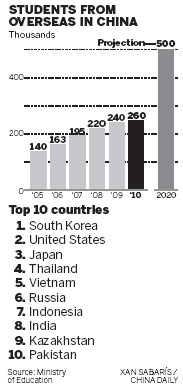Society
Expat student numbers rise in China
By Chen Jia (China Daily)
Updated: 2011-03-04 08:33
 |
Large Medium Small |
 |
|
A worker with an overseas education institution introduces her school to two Chinese students at an international education fair in Beijing on Oct 16, 2010. Provided to China Daily |
BEIJING - The number of foreign students in China has risen dramatically, hitting a record high of more than 260,000 in 2010, according to statistics released by the Ministry of Education (MOE) on Thursday.
A total of 265,090 foreign students from 194 countries came that year to study in China's 620 universities, research institutes and educational institutions, the ministry said.
| ||||
The ministry said it plans to use cooperative educational programs to draw 500,000 foreign students to China by 2020.
The central government provided 800 million yuan ($121.7 million) in scholarships to such students in 2010 and local governments offered about 110 million yuan in scholarships, according to Zhang Xiuqin, director of the department of international cooperation and exchange under the MOE.
The government scholarship benefited a total of 22,390 international students last year. That was 22.7 percent more than had been helped in 2009.
Although the majority of the foreign students enrolled in Chinese schools last year came from Asian countries, the number of students from Western countries increased, official statistics show.
South Korea sent the largest group, followed by the United States, Japan, Thailand, Vietnam, Russia, Indonesia, India, Kazakhstan and Pakistan.
France and Mongolia each sent 5,000 students in 2010.
The Ministry of Education is working with the US to implement a four-year education program initiated by President Hu Jintao and his US counterpart Barack Obama.
US students in China are set to become one of the largest of the foreign groups, as Beijing and Washington work together to bring 100,000 students to China in the next four years, education officials say.
The exchange went both ways.
By the end of 2009, 282 Confucius Institutes and 272 Confucius Classrooms had been established in 88 countries and regions. They were teaching roughly 260,000 students in 2009 - 130,000 more than in 2008 - about China's culture and language, according to the institutes' headquarters.
The figures from the MOE also show that an increasing number of Chinese are choosing to study abroad. The number reached 284,700 in 2010, while the number of Chinese returning from schools overseas was 134,800 for the same year.
US colleges and universities saw their enrollments of Chinese students rise by 30 percent in the 2009-2010 school year, according to a report in the New York Times.
"China's booming economy means that more families can pursue the dream of studying at a university in the US," said Zhang Meng, boss of the Beijing-based overseas study agency CACDIY International.
"However, the application competition will be more fierce this year since US universities have been reducing their scholarships in the wake of the global financial crisis," he said. "I have noticed an increasing number of Chinese students who have to compete for scholarships to pay for the five years' tuition fee needed to get a doctorate in America."
The government published the National Outline for Medium and Long-Term Education Reform and Development (2010-2020) on July 29, calling for an expansion of international cooperation and of exchange among institutions of higher education.
| 分享按钮 |



